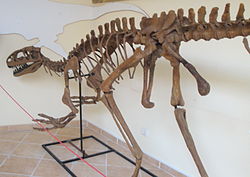Lourinhanosaurus
|
Lourinhanosaurus Temporal range: Late Jurassic, 150 Ma |
|
|---|---|
 |
|
| Reconstructed skeleton, Museum of Lourinhã | |
| Scientific classification | |
| Kingdom: | Animalia |
| Phylum: | Chordata |
| Class: | Reptilia |
| Clade: | Dinosauria |
| Order: | Saurischia |
| Suborder: | Theropoda |
| Genus: |
†Lourinhanosaurus Mateus, 1998 |
| Species: | †L. antunesi |
| Binomial name | |
|
Lourinhanosaurus antunesi Mateus, 1998 |
|
Lourinhanosaurus (meaning "Lourinhã [Formation] lizard") was a carnivorous theropod dinosaur genus that lived during the Late Jurassic Period (Kimmeridgian/Tithonian). Its first remains were found at Peralta, near Lourinhã, Portugal in 1982, but were not described until 1998, by Portuguese paleontologist Octávio Mateus.
Its type (and to date only) species is L. antunesi, in honour of Portuguese paleontologist Miguel Telles Antunes.
To date, the most complete specimen of L. antunesi found is a partial skeleton. The holotype, ML 370, consists of the remains of six cervical vertebrae with six ribs, five sacral vertebrae with ribs, 14 caudal vertebrae, eight chevrons, both femora, right tibia and fibula, one metatarsus, two ilia and both pubes and ischia, as well as an associated 32 gastroliths.
A femur (ML 555) found at Porto das Barcas (Lourinhã Formation; Late Jurassic) has also been referred to L. antunesi.
Besides these specimens, around 100 eggs (specimen number ML 565), some of them containing embryonic bones, have been found in 1993 at the nearby beach of Paimogo. These were in 2001 assigned to L. antunesi.
Both the skeleton and the eggs are on display at Museu da Lourinhã.
Relationships of Lourinhanosaurus have been uncertain, and no firm consensus has been reached as to its relationships. Initially regarded as a primitive member of Allosauroidea, it was later discussed as being closely related to Sinraptoridae, a more inclusive clade within Allosauroidea. Recently, some researchers have been favourable to the idea that L. antunesi is not even an allosauroid, but in fact a member of Megalosauroidea, a more primitive group of tetanuran theropods. Benson et al. (2010) found it and Poekilopleuron to belong to Sinraptoridae. Carrano et al. (2012) found it to be a coelurosaur.
...
Wikipedia
